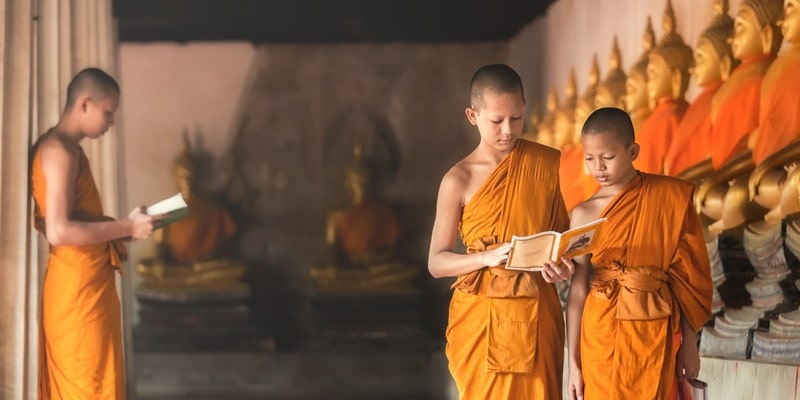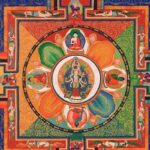We explain what the main religions in the world are, how they can be classified and how many followers each one has. Also, their different beliefs.

What are the religions of the world?
A religion is a set of beliefs and practices through which human beings are linked with what they consider sacred, transcendent or divine, such as gods, supernatural beings, elements of nature identified with supernatural forces or spirituality. Furthermore, these beliefs often establish certain moral values and organize the behavior and worldview of believers.
Since belief systems have existed since prehistory, there have been countless religions over the centuries (many of these survive today). However, not all religions are equally popular on a global scale or have the same number of followers, and they often consist of combinations or reinterpretations of other religions.
Religions are not monolithic blocks, but rather usually group together different groups or subdivide into various sects, branches, currents or churches who share a fundamental belief but differ in their doctrine, rituals or authorities.
Currently, around 4200 religions are recognized which can be classified between:
- theistic religions. They are those that support the belief in the existence of one or more divinities. They are classified as monotheists (who believe in a single god) and polytheists (who believe in the existence of multiple gods).
- Non-theistic religions. They are those that do not admit the existence of one or more absolute, omnipresent or creative gods, but rather a spiritual order or enlightened beings and spirits.
The main religions in the world, in terms of the number of followers (according to 2020 figures), are:
| Religion | Number of followers in the world | Type of religion |
|---|---|---|
| Christianity (Catholicism, Protestantism, Orthodoxy and others) | 2.5 billion people | Monotheistic |
| Islam (Sunism, Shiism, Sufism and others) | 1.9 billion people | Monotheistic |
| Hinduism (Vaisnavism, Shaivism, Smartism, Shaktism and others) | 1.1 billion people | Polytheistic |
| Buddhism (Theravada, Mahayana and Vajrayana) | 535 million people | non-theist |
| Chinese traditional religion | 470 million people | Polytheistic |
| Sikhism | 27 million people | Monotheistic |
| Judaism | 15 million people | Monotheistic |
| Jainism | 6 million people | non-theist |
| Bahaism | 8 million people | Monotheistic |
| American religions of Yoruba origin (Santería, Umbanda, Candomblé and similar) | 1.5 million people | Polytheistic |
| Shintoism (koshitsu, jinja, shuha and minzoku) | 3 million people | Polytheistic |
| Neopaganism (wicca, druidism and similar) | 1 million people | Polytheistic |
| Zoroastrianism | 200,000 people | Monotheistic |
Beliefs of the main religions of the world
Christian religion
The Christian religion is mainly made up of three large branches that share the reading of the Bible and the sign of the cross, since believe that Jesus of Nazareth was the Messiah and the Son of God and that he resurrected after being crucified. However, they differ in their interpretation of the teachings of Jesus and the Scriptures, in the way they understand faith, salvation and worship, and in the structure of their churches. These Christian variants are:
- Catholic Christianity. It is the largest group of Christians in the world and is the only one that remains unified around a single church (the Catholic Church), the same rites and a single spiritual leader: the pope (bishop of Rome).
- Orthodox Christianity. It separated from Catholicism in 1054, and consists of a group of fifteen autocephalous churches (that is, whose bishops are their highest authorities despite recognizing the honorary primacy of the Patriarch of Constantinople) and several autonomous churches (dependent on autocephalous churches), who share some rites and have the same doctrine. It is the heir church of Eastern Christianity, that is, of the variant of Christianity that helped spread the Byzantine Empire throughout the eastern countries.
- Protestant Christianity. It separated from Catholicism starting in the 16th century and includes a wide variety of different churches and Christian movements, each with their respective rites and religious perspectives, which function autonomously from each other.
Islamic religion
The Islamic religion is an Abrahamic religion, as it shares with Christianity and Judaism the belief in one and the same God who, according to the Bible, established a pact with the patriarch Abraham (called Ibrahim in Islam). However, it considers the life and teachings of Muhammad, the founder and main prophet of Islam, who would have lived between the 6th and 7th centuries, as a spiritual guide. The holy book of Muslims is the Koran understood as the word dictated by God (called Allah in Arabic) to Muhammad.
Islam is made up of two main branches, Sunnism (that comprises between 80 and 90% of the Muslim population) and Shiism (which represents between 10 and 15% of the faithful). Added to them are other currents, such as Sufism (a form of Islamic mysticism that can also be practiced by Sunnis and Shiites) and the Ibadi movement (a minority current derived from Kharijism).
Jewish religion
The Jewish religion It is probably the oldest monotheistic religion from which Christianity and Islam are derived. Their belief system is based on the existence of a single creator God, the one who established a pact with Abraham and who gave Moses the tables of the law with the ten commandments.
Their holy book is the Hebrew Bible (also called Tanakh) which broadly corresponds to the Old Testament of the Christian Bible. Other important books are the Talmud and, among scholars of Kabbalah (a mystical interpretation of the Bible), the Zohar. The main currents of Judaism are Orthodox, Reform, Conservative and Reconstructionist.
Hindu religion
Hindu religion It is a set of practices and beliefs that usually constitute a philosophy of life. It is mainly a polytheistic religion, with various divinities and supernatural beings, although it also has monotheistic and pantheistic aspects. Unlike some more structured religions (such as Catholic Christianity), it does not have a single religious leader who heads a uniform hierarchical institution.
A central concept of the Hindu religion is dharma (the law that determines what is right), and some of its fundamental beliefs are reincarnation (samsara) and the effect of good or bad actions on the cycle of reincarnations (karma). His sacred books are Vedasconsidered revealed texts. Added to them are other important books, such as Mahabharatahe Ramayana and the Puranas. Its main currents are Vaisnavism, Shaivism, Shaktism and Smartism. Additionally, many Hindus practice vegetarianism, meditation and yoga.
Buddhist religion
The Buddhist religion is a set of spiritual beliefs and practices that are based on the life and teachings of Buddha (a term that translates as “enlightened”), a prince who became a spiritual teacher between the end of the 6th century and the beginning of the 5th century BC. C and it is believed that he achieved enlightenment. Buddhism It has three main currents: Theravada, Mahayana and Vajrayana. It has in common with Hinduism the belief in samsara (reincarnation) and karmaand call nirvana to liberation from the cycle of rebirth and death.
The doctrinal foundations of Buddhism are known as the Four Noble Truths:
- Existence is suffering or discomfort (dukkha).
- The origin of suffering is the desire for pleasure and the attachment to existence (samudaya).
- Suffering ends when desire and attachment are eliminated (nirodha).
- The elimination of desire and attachment, and with them suffering, is achieved by following a path (magga).
The different currents of Buddhism propose different ways to follow this path towards liberation. However, a path of eight sections is usually recognized: right vision, right determination, right speech, right action, right way of life, right effort, right consciousness and right meditation.
document.addEventListener(“DOMContentLoaded”, (e) => {
var sliderContainer, slider;
sliderContainer = document.getElementById(‘block_b1c8115da6f2444dc86c969a591b25b7’);
if (typeof initSlider !== ‘function’) {
console.log(‘Swiper haven\’t been loaded’);
sliderContainer.className += ‘ fw scroll-snap’;
return;
};
options = {
direction: ‘horizontal’,
speed: 1000,
slidesPerView: ‘auto’,
// slidesPerGroup: 1,
centerInsufficientSlides: true,
// centeredSlides:true,
spaceBetween: 15,
breakpoints: {
720: {
// centeredSlides: false,
// slidesPerGroup: 2,
spaceBetween: 25
},
},
pagination: {
el: ‘.swiper-pagination’,
type: ‘bullets’,
clickable: true
},
}
slider = initSlider(sliderContainer, options);
})
References
- Association of Religion Data Archives (n.d.). World Religion. Association of Religion Data Archives. https://www.thearda.com/
- The Editors of Encyclopaedia Britannica (2024). Religion. Encyclopedia Britannica. https://www.britannica.com/
- Filoramo, G., Massenzio, M., Raveri, M., & Scarpi, P. (2000). History of religions. Criticism.
- Morris, B. (2009). Religion and anthropology. A critical introduction. Akal.
- Pew Research Center (2012). The Global Religious Landscape. Pew Research Center. https://www.pewresearch.org/
- Pew Research Center (2022). Religious Composition by Country, 2010-2050. Pew Research Center. https://www.pewresearch.org/





